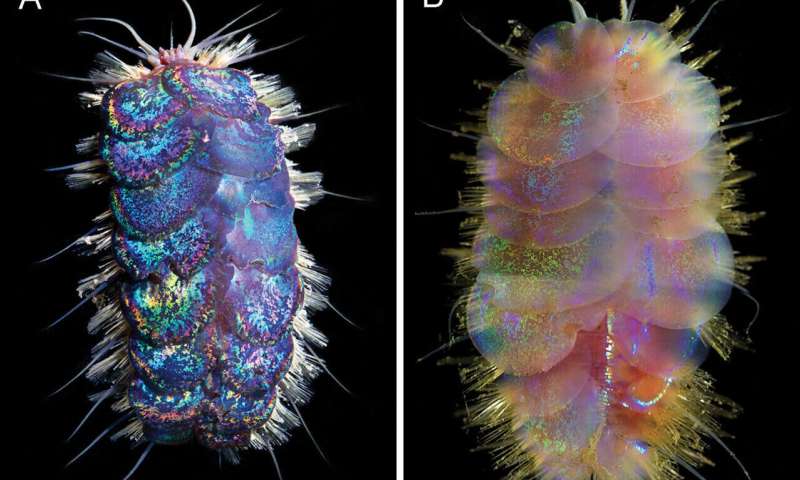by Bob Yirka , Phys.org
MAY 15, 2020 REPORT

Credit: ZooKeys (2020). DOI: 10.3897/zookeys.932.48532
A team of researchers from the University of California and CNRS-Sorbonne Université has identified four species of deep-sea worms that until now have been referred to as Elvis worms. In their paper published in the journal ZooKeys, the group describes the worms, how they were named, and some odd behavior they managed to capture on video.
The researchers described the worms as a few among many that they have been collecting from the seabed over a period of years. Known officially as scale worms, the team had taken to describing them collectively as Elvis worms because their iridescent plated covered shells reminded them of Elvis's sequined jumpsuits. It was only recently that they used genetics to distinguish between four of the most common. In so doing, they formally identified four species: Peinaleopolynoe goffrediae, P. mineoi, P. orphanage and P. elvisi—the first was named in honor of a noted marine biologist, the second after the father of one of the researchers, the man who paid for the research effort, the third was named for a noted geobiologist and the fourth for the famous singer. All four live on the seafloor at depths of 3,000 feet. Several specimens of each species were collected from the bottom of the ocean using a remotely operated vehicle, allowing the team to study the worms in their lab. In the wild, the worms tend to gather around dead whale carcasses or other organic matter as a source of food.
The researchers noted that the worms live in water that is too deep for light to penetrate, thus, other creatures that may live down there with them would not be able to see their shiny, purple, blue and pink iridescent shells, nor would they be able to see each other—they have no eyes. This raises the question of why have a colorful shell. The researchers were not able to answer that question, but suggest that there may be specialty bioluminescent creatures that seek them out. They also note that they were puzzled by notches on the worms' shells until they captured video of two of them fighting, which included dancing jigs in-between dashing over to take a bite out of an opponent's shell.
Explore further Your sushi may serve up parasitic worms
A team of researchers from the University of California and CNRS-Sorbonne Université has identified four species of deep-sea worms that until now have been referred to as Elvis worms. In their paper published in the journal ZooKeys, the group describes the worms, how they were named, and some odd behavior they managed to capture on video.
The researchers described the worms as a few among many that they have been collecting from the seabed over a period of years. Known officially as scale worms, the team had taken to describing them collectively as Elvis worms because their iridescent plated covered shells reminded them of Elvis's sequined jumpsuits. It was only recently that they used genetics to distinguish between four of the most common. In so doing, they formally identified four species: Peinaleopolynoe goffrediae, P. mineoi, P. orphanage and P. elvisi—the first was named in honor of a noted marine biologist, the second after the father of one of the researchers, the man who paid for the research effort, the third was named for a noted geobiologist and the fourth for the famous singer. All four live on the seafloor at depths of 3,000 feet. Several specimens of each species were collected from the bottom of the ocean using a remotely operated vehicle, allowing the team to study the worms in their lab. In the wild, the worms tend to gather around dead whale carcasses or other organic matter as a source of food.
The researchers noted that the worms live in water that is too deep for light to penetrate, thus, other creatures that may live down there with them would not be able to see their shiny, purple, blue and pink iridescent shells, nor would they be able to see each other—they have no eyes. This raises the question of why have a colorful shell. The researchers were not able to answer that question, but suggest that there may be specialty bioluminescent creatures that seek them out. They also note that they were puzzled by notches on the worms' shells until they captured video of two of them fighting, which included dancing jigs in-between dashing over to take a bite out of an opponent's shell.
Explore further Your sushi may serve up parasitic worms
More information: Avery S. Hatch et al. Hungry scale worms: Phylogenetics of Peinaleopolynoe (Polynoidae, Annelida), with four new species, ZooKeys (2020). DOI: 10.3897/zookeys.932.48532
Journal information: ZooKeys
© 2020 Science X Network
No comments:
Post a Comment